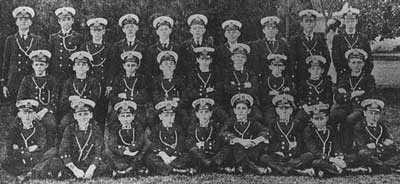A delegation from Military History and Heritage Victoria joined an impressive host of Navy dignitaries on Saturday 2 March 2013 to mark the centenary of the establishment of Australia’s first Naval College at Osborne House in Geelong.
Celebrations included the unveiling a commemorative plaque, a performance by the Royal Australian Navy Band and the Geelong Memorial Brass Band and an exhibition of artefacts and memorabilia.
The Minister for Defence Science and Personnel Warren Snowdon has joined those marking the college’s centenary and paid tribute to those who have taught Australia’s naval officers over the past 100 years.
Event coordinator Cheryl Scott said while the “passage of time” had dimmed local knowledge of Geelong’s defence heritage, the Royal Australian Navy and descendants of original cadets had supported the event wholeheartedly. “This centenary event recognises the opening of the college which was a significant milestone for both the Australian Navy and in Geelong’s history,” she said. “A lot of Geelong residents don’t know about the history, but Osborne House is very important to Australian history and the navy has embraced this event enormously because it is very important to them.”
Prior to 1 March 1913, Navy Cadets were sent to England for Officer Training. The Australian Navy sought to have cadets trained at home so as not to lose their “Australian-ness”, but the facility at Jervis Bay in NSW was not due for completion for another two years. Osborne House was selected as a temporary facility to become the first Royal Australian Naval College.
In 1913 the Navy took up offer to use the house as a naval college.
Improvements to the buildings were carried out, including the erection of block of buildings as quarters for unmarried seamen, two new classrooms, and alterations to the main room to provide a large barrack for 28 cadets. The college was opened by the Governor General, Lord Thomas Denman on March 1, 1913, with Prime Minister Andrew Fisher also present. Lord Denman arrived by torpedo boat, with 200 invited guests arriving by train from Melbourne.
The college housed 28 cadets, 4 petty officers, and 10 seamen, together with the professors, instructors and domestics. The initial class of 28 cadets was chosen from 137 candidates. It was considered as a permanent location for the naval college as it was close to rail transport and had safe anchorage in Corio Bay, but the college was relocated to HMAS Creswell at Jervis Bay in 1915.
The first two intakes of cadet midshipmen, all aged 12 and 13, came to Geelong by steam train from all over Australia on March 1, 1913 and stayed until a permanent facility at Jervis Bay opened in 1915.
The ceremony was attended by the Chief of Navy Vice Admiral Ray Griggs AO, CSC, RAN who inspected a guard contingent from HMAS Cerberus, local Naval Cadets and the Navy Band. Vice Admiral Peter Jones AO, DSC, RAN also delivered an address on the history of the Royal Australian Naval College.
“Some of our most distinguished naval officers including Admirals Collins and Farncomb, and Captain Waller were first trained in this building. Osborne House is an incredibly important link in Australian Navy history,” said Mr Snowdon.
Fifteen descendants of the original Osborne House cadets also attended the event after travelling from as far afield as England, Queensland and NSW.
The Naval College was based at Osborne House until 1915, after that it served as a Naval Convalescent Hospital, the home of Australia’s first submarine fleet between 1919 and 1924, a training base during the Second World War and the headquarters for the Shire of Corio for some 50 years.

Contact Military History and Heritage Victoria about this article.






